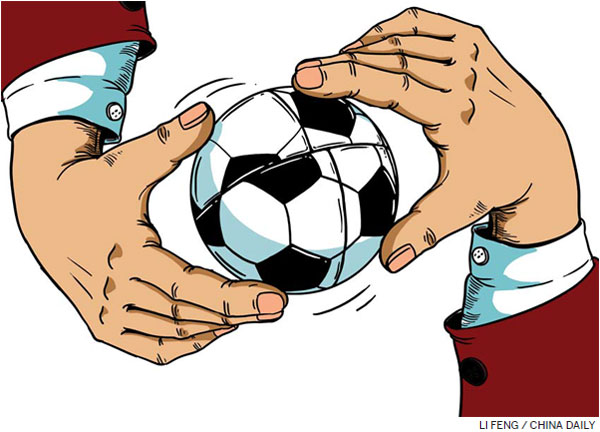A game plan for Chinese football at last
Updated: 2016-04-29 08:25
By Lei Lei(China Daily Europe)
|
|||||||||
Beijing plans ambitious long-term goal for the sport and the policy to boost it is a welcome move
While China continues to struggle to qualify for the 2018 World Cup, it has set an ambitious goal to become a dominant football nation in Asia by 2030 and a global power by 2050.
The National Development and Reform Commission, the top economic planner, announced the long-term goal this month, and although some fans doubt whether it can be realized, the policy to boost Chinese football is a welcome move.

Such plans have been implemented in the past by the traditional Asian powers, Japan and South Korea, as well as World Cup winners Brazil and Germany.
In 2013, the South Korean football association set a goal of becoming a top-10 side by 2033 and promised 300 billion won ($260 million; 231 million euros) to support the plan, which also includes increase the number of players to 10 million. As a result, the South Korean men's national team now plays more friendlies with top teams, while the country has also won the right to host the 2017 Under-20 World Cup.
Japan's reform started in 1991. Thanks to decades of efforts, it now has a multi-tiered league made up of 28,000 teams and 4.8 million players, which is equal to Italy. The Japanese national team has appeared in four World Cup finals in the past 20 years.

The English Football Association started a grassroots program last year and plans to spend 250 million pounds ($361 million; 321 million euros) to build more fields and train more coaches.
The rejuvenation of football in Germany also started with a reform. During 2001 and 2002, clubs nationwide began setting up training schools for children, drawing the young generation back to the game. Germany went on to regain the top spot in the world rankings and won the 2014 World Cup.
After being beaten 7-1 by Germany in the semifinals that year, the host Brazil increased its investment in the youth training. Last year, the football-crazy nation set up a new national training center for talented youngsters.
Learning from the experiences of these giants, China has chosen to move on reform track, starting with youth.
According to its short-term plan (2016-20), China will establish a three-tier amateur league that will include grassroots clubs in 100 cities and could involve more than 50 million people. About 70,000 pitches will be built, while the number of schools specializing in football training is set to increase from 8,000 to 20,000.
With state support, Chinese football can form a virtuous circle like those in Western and South American countries.
Today, if a boy in England wants to play the beautiful game, his parents have only to visit the official website of the sports governing body, the Football Association, and type in their address to get detailed information on a center providing free coaching close to their home.
To test the effectiveness of China's reform, a good criterion may be to check after a decade or so whether a young Chinese person can find a training academy as easily as an English peer.
The author is an editor with China Daily. Contact her at leilei@chinadaily.com.cn
Today's Top News
Inspectors to cover all of military
Britons embrace 'Super Thursday' elections
Campaign spreads Chinese cooking in the UK
Trump to aim all guns at Hillary Clinton
Labour set to take London after bitter campaign
Labour candidate favourite for London mayor
Fossil footprints bring dinosaurs to life
Buffett optimistic on China's economic transition
Hot Topics
Lunar probe , China growth forecasts, Emission rules get tougher, China seen through 'colored lens', International board,
Editor's Picks

|

|

|

|

|

|







